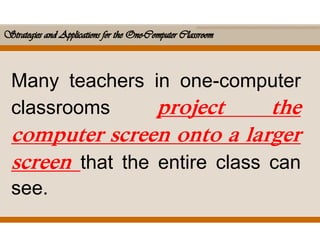Strategies and applications for the one computer classroom_clarito
- 1. Clarito, Leander Camille Z. III - BSITE
- 2. Post a schedule. Allow a set amount of time for each student at the computer station. Students are responsible for getting to the station at the appointed time.
- 3. Draw Popsicle sticks. Write each student's name on a Popsicle stick. Place the can of Popsicle sticks at the computer station. Draw a stick at the start of the day. The person whose name is on the stick will start the day at the station. That student will draw a stick to determine who goes next.
- 4. Place Class Roster by Computers ? Students check off their names when they have been at the computer and finish the activity or lesson. ? Each student when finished selects another student without a check by their name to go to one of the computers.
- 5. Individual Student Sign-Up ? Use a Sign-Up sheet for students to sign-up when they are ready. ? Limit the number of times and minutes at the computer for each student. (use timer) ? Try to use computer time for projects and activities related to content area.
- 6. Using Clothespins ? Make a poster with ˇ°waitingˇ± on one side and ˇ°Completedˇ± on the other side. ? Tape a thick string down the middle of the poster. ? Use a marker and write each studentsˇŻ name on both sides of a clothespin. ? Point the clothespins with the name on the waiting side with the first four computers first. ? When each student finishes, let it be their responsibility to get another student whoˇŻs name is next in order on the waiting side. ? You can rotate the order of the clothespins at the beginning of a project so students get equal access on the computer
- 7. Establish color-coded groups. Divide the class into five groups. Write the names of each group on a different sheet of colored paper, and post the papers by the computer station. The students in each group will spend time at the computer on a given day (for example, the students in the red group will have computer time on Mondays). The students within a group will go to the computer in assigned or random order.
- 8. Many teachers in one-computer classrooms project the computer screen onto a larger screen that the entire class can see.
- 9. Computer as Presentation Tool ? Connect one computer to large TV monitor. ? Demonstrate what you expect students to do for projects. ? Model an example project to students ? Give clear written instructions for project work.
- 10. Establish color-coded groups. Divide the class into five groups. Write the names of each group on a different sheet of colored paper, and post the papers by the computer station. The students in each group will spend time at the computer on a given day (for example, the students in the red group will have computer time on Mondays). The students within a group will go to the computer in assigned or random order.










